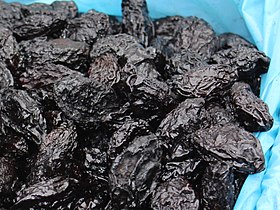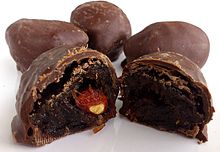Prune: Difference between revisions
Ponsonby100 (talk | contribs) Undid revision 1147550538 by The Blind Fish Universe Authority (talk) |
Cold Season (talk | contribs) |
||
| (13 intermediate revisions by 9 users not shown) | |||
| Line 38: | Line 38: | ||
}} |
}} |
||
A '''prune''' is a dried [[plum]], most commonly from the |
A '''prune''' is a dried [[plum]], most commonly from the European plum (''[[Prunus domestica]]'') tree. Not all plum species or varieties can be dried into prunes.<ref>{{cite book|title=Growing Prunes (Dried Plums) in California: An Overview|url=https://books.google.com/books?id=GxxjwNoAHgcC |year=2007 |publisher=UCANR Publications|isbn=978-1-60107-486-7}}</ref> A prune is the firm-fleshed fruit (plum) of ''Prunus domestica'' varieties that have a high soluble solids content, and do not [[Fermentation|ferment]] during [[Dried fruit|drying]].<ref name="Buchner2012">{{cite book|author=Richard P. Buchner |title=Prune Production Manual|url=https://books.google.com/books?id=ZIOk7KIgDVAC&pg=PA75|date=16 May 2012|publisher=UCANR Publications|isbn=978-1-60107-702-8|pages=75–}}</ref> Use of the term "prune" for fresh plums is obsolete except when applied to varieties of plum grown for drying.<ref name="usda">{{cite web|url=https://www.ams.usda.gov/grades-standards/dehydrated-prunes-grades-and-standards|title=Dehydrated Prunes Grades and Standards |publisher=Agricultural Marketing Service, US Department of Agriculture|date=2017|access-date=15 May 2017}}</ref> |
||
Most prunes are [[Drupe#Terminology|''freestone'']] cultivars (the [[Pyrena|pit]] is easy to remove), whereas most plums grown for fresh consumption are ''clingstone'' (the pit is more difficult to remove). |
Most prunes are [[Drupe#Terminology|''freestone'']] cultivars (the [[Pyrena|pit]] is easy to remove), whereas most plums grown for fresh consumption are ''clingstone'' (the pit is more difficult to remove). |
||
| Line 51: | Line 51: | ||
==Health effects== |
==Health effects== |
||
Prunes contain [[dietary fiber]] (about 7% of weight |
Prunes contain [[dietary fiber]] (about 7% of weight) which may provide [[laxative]] effects.<ref name=critrev/> Their [[sorbitol]] content may also be responsible for this, a conclusion reached in a 2012 review by the [[European Food Safety Authority]].<ref name="efsa2012"/> The report also demonstrated that prunes effectively contribute to the maintenance of normal bowel function in the general population if consumed in quantities of at least {{convert|100|g|oz}} per day.<ref name="efsa2012">{{cite journal |title=Scientific Opinion on the substantiation of health claims related to dried plums of 'prune' cultivars (''Prunus domestica'' L.) and maintenance of normal bowel function (ID 1164, further assessment) pursuant to Article 13(1) of Regulation (EC) No 1924/2006 |doi=10.2903/j.efsa.2012.2712 |journal=EFSA Journal |volume=10 |issue=6 |page=2712 |author=EFSA Panel on Dietetic Products, Nutrition and Allergies (NDA) |year = 2012|doi-access=free }}</ref> |
||
===Nutrition=== |
===Nutrition=== |
||
Prunes are 31% water, 64% [[carbohydrate]]s, including 7% dietary fiber, 2% [[protein]], and less than 1% [[fat]] |
Prunes are 31% water, 64% [[carbohydrate]]s, including 7% dietary fiber, 2% [[protein]], and less than 1% [[fat]]. Prunes are a moderate source of [[vitamin K]] (57% of the [[Daily Value]], DV) and a moderate source of several [[B vitamin]]s and [[dietary minerals]] (4–16% DV). |
||
===Phytochemicals=== |
===Phytochemicals=== |
||
| Line 60: | Line 60: | ||
==Uses== |
==Uses== |
||
[[File:Chocolate-coated Dried Plums.jpg|right|thumb| |
[[File:Chocolate-coated Dried Plums.jpg|right|thumb|[[Chocolate-covered prune|Prunes in chocolate]] with an [[almond]] in the middle]] |
||
[[File:Tajin aux pruneaux.JPG|right|thumb|[[Moroccan cuisine|Moroccan]]-style [[tagine]] of lamb with prunes and almonds]] |
[[File:Tajin aux pruneaux.JPG|right|thumb|[[Moroccan cuisine|Moroccan]]-style [[tagine]] of lamb with prunes and almonds]] |
||
Prunes are used in preparing both [[Sweet dishes|sweet]] and savory [[Culinary dish|dishes]].<ref name=efsa2012/> |
Prunes are used in preparing both [[Sweet dishes|sweet]] and savory [[Culinary dish|dishes]].<ref name=efsa2012/> |
||
| Line 73: | Line 72: | ||
* {{annotated link|List of plum dishes}} |
* {{annotated link|List of plum dishes}} |
||
* {{annotated link|Pomology}} |
* {{annotated link|Pomology}} |
||
* [[Li hing mui]] |
|||
==References== |
==References== |
||
Latest revision as of 10:42, 22 May 2024


| Nutritional value per 100 g (3.5 oz) | |||||||||||||||||||||||||||||||||||||||||||||||||||
|---|---|---|---|---|---|---|---|---|---|---|---|---|---|---|---|---|---|---|---|---|---|---|---|---|---|---|---|---|---|---|---|---|---|---|---|---|---|---|---|---|---|---|---|---|---|---|---|---|---|---|---|
| Energy | 1,006 kJ (240 kcal) | ||||||||||||||||||||||||||||||||||||||||||||||||||
63.88 g | |||||||||||||||||||||||||||||||||||||||||||||||||||
| Sugars | 38.13 g | ||||||||||||||||||||||||||||||||||||||||||||||||||
| Dietary fiber | 7.1 g | ||||||||||||||||||||||||||||||||||||||||||||||||||
0.38 g | |||||||||||||||||||||||||||||||||||||||||||||||||||
2.18 g | |||||||||||||||||||||||||||||||||||||||||||||||||||
| |||||||||||||||||||||||||||||||||||||||||||||||||||
| Other constituents | Quantity | ||||||||||||||||||||||||||||||||||||||||||||||||||
| Water | 31 g | ||||||||||||||||||||||||||||||||||||||||||||||||||
| †Percentages estimated using US recommendations for adults,[1] except for potassium, which is estimated based on expert recommendation from the National Academies.[2] | |||||||||||||||||||||||||||||||||||||||||||||||||||
A prune is a dried plum, most commonly from the European plum (Prunus domestica) tree. Not all plum species or varieties can be dried into prunes.[3] A prune is the firm-fleshed fruit (plum) of Prunus domestica varieties that have a high soluble solids content, and do not ferment during drying.[4] Use of the term "prune" for fresh plums is obsolete except when applied to varieties of plum grown for drying.[5]
Most prunes are freestone cultivars (the pit is easy to remove), whereas most plums grown for fresh consumption are clingstone (the pit is more difficult to remove).
Prunes are 64% carbohydrates, including dietary fiber, 2% protein, a rich source of vitamin K, and a moderate source of B vitamins and dietary minerals. The sorbitol content of dietary fiber likely provides the laxative effect associated with consuming prunes.
Production
[edit]More than 1,000 plum cultivars are grown for drying. The main cultivar grown in the United States is the 'Improved French' prune. Other varieties include 'Sutter', 'Tulare Giant', 'Moyer', 'Imperial', 'Italian', and greengages. Fresh prunes reach the market earlier than fresh plums and are usually smaller in size. The great majority of commercially grown prune varieties are self-fertile and do not need separate pollinator trees.[6]
Name change
[edit]In 2001, plum growers in the United States were authorized by the Food and Drug Administration to call prunes "dried plums".[7] Due to a perception that prunes relieve constipation (perceived as derogatory), some distributors stopped using the word "prune" on packaging labels in favor of "dried plums".[8]
Health effects
[edit]Prunes contain dietary fiber (about 7% of weight) which may provide laxative effects.[9] Their sorbitol content may also be responsible for this, a conclusion reached in a 2012 review by the European Food Safety Authority.[10] The report also demonstrated that prunes effectively contribute to the maintenance of normal bowel function in the general population if consumed in quantities of at least 100 grams (3.5 oz) per day.[10]
Nutrition
[edit]Prunes are 31% water, 64% carbohydrates, including 7% dietary fiber, 2% protein, and less than 1% fat. Prunes are a moderate source of vitamin K (57% of the Daily Value, DV) and a moderate source of several B vitamins and dietary minerals (4–16% DV).
Phytochemicals
[edit]Prunes and prune juice contain phytochemicals, including phenolic compounds (mainly as neochlorogenic acids and chlorogenic acids) and sorbitol.[9]
Uses
[edit]

Prunes are used in preparing both sweet and savory dishes.[10]
Contrary to the name, boiled plums or prunes are not used to make sugar plums, which instead may be nuts, seeds, or spices coated with hard sugar, also called comfits.[11]
See also
[edit]- List of dried foods
- List of plum dishes
- Pomology – Study of fruits and their cultivation
- Li hing mui
References
[edit]- ^ United States Food and Drug Administration (2024). "Daily Value on the Nutrition and Supplement Facts Labels". FDA. Archived from the original on 27 March 2024. Retrieved 28 March 2024.
- ^ National Academies of Sciences, Engineering, and Medicine; Health and Medicine Division; Food and Nutrition Board; Committee to Review the Dietary Reference Intakes for Sodium and Potassium (2019). "Chapter 4: Potassium: Dietary Reference Intakes for Adequacy". In Oria, Maria; Harrison, Meghan; Stallings, Virginia A. (eds.). Dietary Reference Intakes for Sodium and Potassium. The National Academies Collection: Reports funded by National Institutes of Health. Washington, DC: National Academies Press (US). pp. 120–121. doi:10.17226/25353. ISBN 978-0-309-48834-1. PMID 30844154. Retrieved 5 December 2024.
- ^ Growing Prunes (Dried Plums) in California: An Overview. UCANR Publications. 2007. ISBN 978-1-60107-486-7.
- ^ Richard P. Buchner (16 May 2012). Prune Production Manual. UCANR Publications. pp. 75–. ISBN 978-1-60107-702-8.
- ^ "Dehydrated Prunes Grades and Standards". Agricultural Marketing Service, US Department of Agriculture. 2017. Retrieved 15 May 2017.
- ^ Growing Prunes (Dried Plums) in California: An Overview. UCANR Publications. 2007. pp. 2–. ISBN 978-1-60107-486-7.
- ^ "FDA Approves Prune Name Change". ABC News. 6 January 2006. Retrieved 14 July 2016.
- ^ Janick, Jules and Robert E. Paull (2008). The Encyclopedia of Fruit and Nuts. CABI. ISBN 0-85199-638-8. p. 696.
- ^ a b Stacewicz-Sapuntzakis, M; Bowen, PE; Hussain, EA; Damayanti-Wood, BI; Farnsworth, NR (2001). "Chemical composition and potential health effects of prunes: a functional food?". Critical Reviews in Food Science and Nutrition. 41 (4): 251–86. doi:10.1080/20014091091814. PMID 11401245. S2CID 31159565.
- ^ a b c EFSA Panel on Dietetic Products, Nutrition and Allergies (NDA) (2012). "Scientific Opinion on the substantiation of health claims related to dried plums of 'prune' cultivars (Prunus domestica L.) and maintenance of normal bowel function (ID 1164, further assessment) pursuant to Article 13(1) of Regulation (EC) No 1924/2006". EFSA Journal. 10 (6): 2712. doi:10.2903/j.efsa.2012.2712.
- ^ Kawash, Samira (22 December 2010). "Sugar Plums: They're Not What You Think They Are". The Atlantic. Retrieved 13 July 2017.
